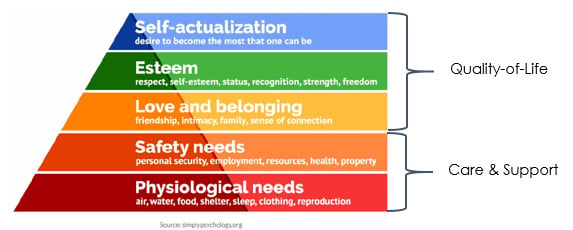Maslow Got It Right!
February 24, 2020

Marketers targeting seniors often miss the bull's-eye with their messaging. The problem is, messaging usually focuses on how a featured product or service aids a senior’s daily living rather than how it enhances life.
There is a reason for this. Ads are usually created from the perspective of a caregiver or the adult child of the senior, who sees seniors as needy.
As a result, these ads don’t make an emotional connection; they don’t tug at the senior’s heartstrings. But there’s a better way!
Seniors & Maslow’s Hierarchy of Needs
At its core, there are two general perspectives to consider when formulating any marketing message directed at the senior cohort:
- The promise of addressing a need that accompanies aging – that is, care and support for senior.
- The promise of enabling them to thrive – how it improves a senior’s quality-of-life.
These perspectives are reflected in Abraham Maslow’s Hierarchy of Needs, where the more basic needs must be met before higher needs are considered.

Care and support messaging relates to the base levels in Maslow’s hierarchy – physiological and safety needs – promising the senior’s daily living requirements are addressed effectively . Quality-of-life messaging relates to Maslow’s higher needs – love & belonging, esteem, and self-actualization – that become priorities after those more basic “care and support” needs are met.
The tendency among mostly younger marketers is to focus messaging on how an advertised product or service helps an aging adult to live more comfortably, because this is perceived as the aging adult’s most important priority.
Conversely, quality-of-life impacts a senior’s thriving and enjoyment of living. Aspects such as dignity, growth (experiences, knowledge), financial security and autonomy are foundational to the senior’s quality-of-life. These aspects contribute to the joy seniors derive from living.
There is no joy inherent in “care and support” messaging. Therefore, it does not capture a senior’s heart, because most seniors are not ready to be put on a shelf. They still have life they want to live!
Who is making the purchase decision anyway?
When the focus of a selling message is “care and support,” there is no emotional edge to attract the senior consumer. Purchase decisions that relate to care and/or support are more readily received by a caregiver or child of a senior, rather than the senior himself. Any suggestion of “joy” communicated in such messaging is usually disingenuous, making the messaging not believable. Hence, the purchase decision is ultimately based on more concrete criteria – price, utility delivered, etc.
However, an advertising message that delivers a promise of better quality-of-life will be more readily embraced by the older adults.
Capturing the heart of the senior consumer
Senior consumers are no different than their younger counterparts. They don’t want to simply live out their lives comfortably. They want to be valued. They want the dignity and respect they deserve for their stage and position in life. And they want to thrive.
Messaging that resonates with a senior’s self-perception and addresses his or her craving for the best possible quality-of-life will be readily embraced.





